January 2024
Diagnosis of Pain and Discoloration of Toes
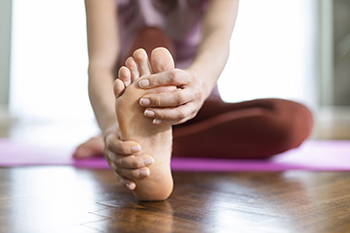
Toe pain can have various causes, and it is necessary to consider a number of possibilities to determine the underlying condition accurately. Cellulitis, a bacterial skin infection, can lead to toe pain accompanied by symptoms like redness, swelling, warmth, and sometimes fever. Cryoglobulinemia, although rare, can result in recurrent skin discoloration, known as palpable purpura, on the lower extremities, often associated with joint pain and kidney issues. Trauma is another common cause, with toe pain following a history of injury, typically displaying corresponding contusion patterns. Warfarin skin necrosis, a rare complication of anticoagulant therapy, may present as painful skin necrosis in areas with accumulated fat during the beginning of warfarin use. Lastly, blue toe syndrome can cause acute, painful cyanotic discoloration in the toes due to an embolism. If you have painful, discolored, or swollen toes and there is no obvious cause, or one that needs attention, it is suggested that you schedule an appointment with a podiatrist for a proper diagnosis and treatment.
Toe pain can disrupt your daily activities. If you have any concerns, contact Eveleigh Williams, DPM of Sole 2 Sole, PC. Our doctor can provide the care you need to keep you pain-free and on your feet.
What Causes Toe Pain?
Most severe toe pain is caused due to a sports injury, trauma from dropping something heavy on the toe, or bumping into something rigid. Other problems can develop over time for various reasons.
Toe pain can be caused by one or more ailments. The most common include:
- Trauma
- Sports injury
- Wearing shoes that are too tight
- Arthritis
- Gout
- Corns and calluses
- Hammertoe
- Bunions
- Blisters
- Ingrown toenails
- Sprains
- Fractures (broken bones)
- Dislocations
When to See a Podiatrist
- Severe pain
- Persistent pain that lasts more than a week
- Signs of infection
- Continued swelling
- Pain that prevents walking
Diagnosis
In many cases the cause of toe pain is obvious, but in others, a podiatrist may want to use more advanced methods to determine the problem. These can range from simple visual inspections and sensation tests to X-rays and MRI scans. Prior medical history, family medical history, and any recent physical traumatic events will all be taken into consideration for a proper diagnosis.
Treatment
Treatments for toe pain and injuries vary and may include shoe inserts, padding, taping, medicines, injections, and in some cases, surgery. If you believe that you have broken a toe, please see a podiatrist as soon as possible.
If you have any questions please feel free to contact our office located in Olympia Fields, IL . We offer the newest diagnostic tools and technology to treat your foot and ankle needs.
Long Term Ankle Sprain Treatment
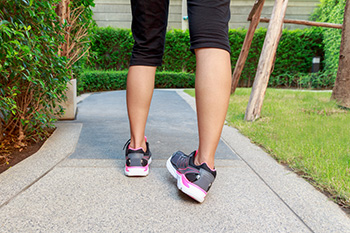
Ankle sprains are a common foot injury, affecting approximately 25,000 people daily. They demand swift and accurate treatment to avoid prolonged recovery times. The emphasis is to heal the injured ankle as well as reduce the risk of chronic sprains. Ankle sprains occur when ligaments on the outer side of the joint are stretched or torn due to the inward or outward rolling of the foot. These are known as inversion or eversion sprains. Adequate rest and rehabilitation during the early recovery phase is essential and can range from days to months, based on severity. Complete healing lays the foundation for preventing long term issues. Engaging in targeted exercises to strengthen legs, feet, and ankles is essential for restoring balance and normal function to the tendons, joints, and muscles of the ankle. Further, wearing ankle braces or bandages during activities that stress ligaments can help to protect and stabilize the ankle. Choosing well-fitted, activity-specific footwear is equally important, with considerations for high-top or hiking boots during the recovery phase for enhanced ankle stability. In severe cases, surgical intervention may be recommended to repair torn or stretched ligaments. For help with managing ankle sprains, it is suggested that you schedule an appointment with a podiatrist.
Although ankle sprains are common, they aren’t always minor injuries. If you need your ankle injury looked at, contact Eveleigh Williams, DPM from Sole 2 Sole, PC. Our doctor can provide the care you need to keep you pain-free and on your feet.
How Does an Ankle Sprain Occur?
Ankle sprains are the result of a tear in the ligaments within the ankle. These injuries may happen when you make a rapid shifting movement while your foot is planted. A less common way to sprain your ankle is when your ankle rolls inward while your foot turns outward.
What Are the Symptoms?
- Pain at the sight of the tear
- Bruising/Swelling
- Ankle area is tender to touch
- In severe cases, may hear/feel something tear
- Skin discoloration
Preventing a Sprain
- Wearing appropriate shoes for the occasion
- Stretching before exercises and sports
- Knowing your limits
Treatment of a Sprain
In many cases, the RICE method (Rest, Ice, Compression, and Elevate) is used to treat ankle sprains. However, you should see a podiatrist to see which treatment option would work best with your injury. In severe cases, surgery may be required.
It is important to ask your doctor about rehab options after you receive treatment for your injury. Stretching, strength training, and balance exercises may help the ankle heal while also preventing further injury.
If you have any questions, please feel free to contact our office located in Olympia Fields, IL . We offer the newest diagnostic and treatment technologies for all your foot care needs.
Adult Feet Versus Children's Feet
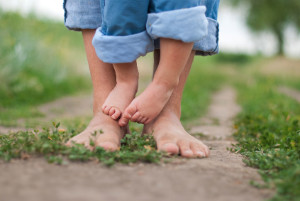
As we explore the realm of podiatry, the disparities between adult and children's feet unfold like chapters in an evolutionary narrative. Adults, with fully developed skeletal structures, boast arches that have endured the test of time, providing stability and balance. In contrast, children's feet can be likened to blank canvases, each step imprinting a unique pattern of growth. The arches are pliable and unfixed, mirroring the malleability of childhood itself. Ligaments and tendons, gradually gaining resilience, transform these delicate feet into the robust foundation required for a lifetime of mobility. The bones, still in the process of ossification, reflect the ongoing saga of physical development. If you notice that your child exhibits foot development problems, it is suggested that you consult a podiatrist for a thorough exam and diagnosis.
The health of a child’s feet is vital to their overall well-being. If you have any questions regarding foot health, contact Eveleigh Williams, DPM of Sole 2 Sole, PC. Our doctor can provide the care you need to keep you pain-free and on your feet.
Tips for Keeping Children's Feet Healthy
- Make sure their shoes fit properly
- Look for any signs of in-toeing or out-toeing
- Check to see if they have Clubfoot (condition that affects your child’s foot and ankle, twisting the heel and toes inward) which is one of the most common nonmajor birth defects.
- Lightly cover your baby’s feet (Tight covers may keep your baby from moving their feet freely, and could prevent normal development)
- Allow your toddler to go shoeless (Shoes can be restricting for a young child’s foot)
- Cut toenails straight across to avoid ingrown toenails
- Keep your child’s foot clean and dry
- Cover cuts and scrapes. Wash any scratches with soap and water and cover them with a bandage until they’ve healed.
If you have any questions, please feel free to contact our office located in Olympia Fields, IL . We offer the newest diagnostic and treatment technologies for all your foot care needs.
Causes of Gout
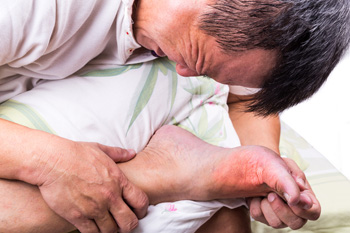
Gout is a painful inflammatory arthritis that often affects the big toe joint. It occurs when urate, a byproduct of purines found in body tissues and certain foods, accumulates and forms needle-shaped crystals in joints. This buildup results in redness, swelling, and extreme pain, disrupting the normal functioning of the affected joint. While high urate levels are a primary factor of causing gout, not everyone with elevated urate experiences gout. Genetics and environmental elements play roles in the urate accumulation process. Several factors increase the likelihood of gout, including familial history, male gender, menopause, advancing age, and alcohol consumption. Dietary choices also influence urate levels. Foods rich in purines, particularly those from animal sources, contribute to urate production. Additionally, habits such as consuming sugar-sweetened beverages amplify the risk. Certain health conditions add to the susceptibility for gout. Obesity, metabolic syndrome, chronic kidney disease, and high blood pressure can elevate urate levels. For advice in managing gout in the big toe or ankle, it is suggested that you schedule an appointment with a podiatrist.
Gout is a painful condition that can be treated. If you are seeking treatment, contact Eveleigh Williams, DPM from Sole 2 Sole, PC. Our doctor will treat your foot and ankle needs.
What Is Gout?
Gout is a form of arthritis that is characterized by sudden, severe attacks of pain, redness, and tenderness in the joints. The condition usually affects the joint at the base of the big toe. A gout attack can occur at any random time, such as the middle of the night while you are asleep.
Symptoms
- Intense Joint Pain - Usually around the large joint of your big toe, and it most severe within the first four to twelve hours
- Lingering Discomfort - Joint discomfort may last from a few days to a few weeks
- Inflammation and Redness -Affected joints may become swollen, tender, warm and red
- Limited Range of Motion - May experience a decrease in joint mobility
Risk Factors
- Genetics - If family members have gout, you’re more likely to have it
- Medications - Diuretic medications can raise uric acid levels
- Gender/Age - Gout is more common in men until the age of 60. It is believed that estrogen protects women until that point
- Diet - Eating red meat and shellfish increases your risk
- Alcohol - Having more than two alcoholic drinks per day increases your risk
- Obesity - Obese people are at a higher risk for gout
Prior to visiting your podiatrist to receive treatment for gout, there are a few things you should do beforehand. If you have gout you should write down your symptoms--including when they started and how often you experience them, important medical information you may have, and any questions you may have. Writing down these three things will help your podiatrist in assessing your specific situation so that he or she may provide the best route of treatment for you.
If you have any questions, please feel free to contact our office located in Olympia Fields, IL . We offer the newest diagnostic and treatment technologies for all your foot care needs.
Do You Suffer From Painful Feet?
Definition and Symptoms of an Achilles Tendon Injury
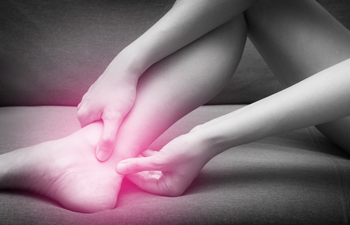
The Achilles tendon, a strong band of tissue connecting the calf muscles to the heel bone, plays a pivotal role in facilitating movement. An Achilles tendon injury refers to the damage or inflammation that occurs in this critical structure, impacting the ability to walk, run, or perform various physical activities. Typically, injuries to the Achilles tendon manifest as pain, swelling, and stiffness, often concentrated near the back of the heel. Individuals may experience difficulty pointing their toes or pushing off the ground. The discomfort can range from mild to severe, and in some cases, a noticeable thickening of the tendon may be observed. Achilles tendon injuries are frequently associated with overuse, sudden increases in physical activity, or inadequate warm-up routines. If you have endured an Achilles tendon injury, it is suggested that you confer with a podiatrist who can guide you toward the correct treatment method.
Achilles tendon injuries need immediate attention to avoid future complications. If you have any concerns, contact Eveleigh Williams, DPM of Sole 2 Sole, PC. Our doctor can provide the care you need to keep you pain-free and on your feet.
What Is the Achilles Tendon?
The Achilles tendon is a tendon that connects the lower leg muscles and calf to the heel of the foot. It is the strongest tendon in the human body and is essential for making movement possible. Because this tendon is such an integral part of the body, any injuries to it can create immense difficulties and should immediately be presented to a doctor.
What Are the Symptoms of an Achilles Tendon Injury?
There are various types of injuries that can affect the Achilles tendon. The two most common injuries are Achilles tendinitis and ruptures of the tendon.
Achilles Tendinitis Symptoms
- Inflammation
- Dull to severe pain
- Increased blood flow to the tendon
- Thickening of the tendon
Rupture Symptoms
- Extreme pain and swelling in the foot
- Total immobility
Treatment and Prevention
Achilles tendon injuries are diagnosed by a thorough physical evaluation, which can include an MRI. Treatment involves rest, physical therapy, and in some cases, surgery. However, various preventative measures can be taken to avoid these injuries, such as:
- Thorough stretching of the tendon before and after exercise
- Strengthening exercises like calf raises, squats, leg curls, leg extensions, leg raises, lunges, and leg presses
If you have any questions please feel free to contact our office located in Olympia Fields, IL . We offer the newest diagnostic tools and technology to treat your foot and ankle needs.









